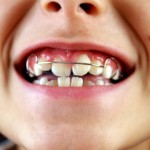
Undertaking orthodontic procedures early may help to prevent problems arising or reduce the severity of the developing malocclusion; it may also be part of a ‘two-phase’ treatment plan. However the effectiveness of early treatment has been the subject of debate. The aim of this review was to determine whether interceptive orthodontics prior to the age of 11 years is more effective than later treatment in the short- and long-term.
Methods
Searches were conducted in Medline, Embase, Cochrane Oral Health Group’s Trials Register, the Cochrane Central Register of Controlled Trials (CENTRAL), LILACS, BBO, ClinicalTrials.gov, the National Research Register and Pro-Quest Dissertation Abstracts and Thesis database.
Randomised controlled trials (RCTs) and controlled trials (CCTs) in patients under 11 years at the start of treatment for a range of interventions eg. interceptive extractions, space maintenance, crossbite correction, habit dissuasion were considered. Two reviewers abstracted data independently and quality assessed using the Cochrane risk of bias tool. The overall quality of evidence was to be assessed using GRADE.
Results
- 22 studies (18 RCTs, 3 CCTs) were included.
- 20 were considered to be at low or unclear risk of bias.
- Meta-analysis was possible for 11 comparisons.
- For Class II correction in the short-term, meta-analyses demonstrated
- a statistically significant reduction in ANB (-1.4 degrees, 95 CI: -2.17, -0.64) and overjet (-5.81mm, 95 CI: -6.37, -5.25) with both functional appliances and headgear versus control.
- For Class II correction in the long-term, however, statistical significance was not found for the same outcomes. Treatment duration was prolonged with both functional appliances (6.85 months, 95 CI: 3.24, 10.45) and headgear (12.47 months, 95 CI: 8.67, 16.26) compared to adolescent treatments.
- Meta-analyses were not possible for comparisons of other interceptive treatments due to heterogeneity and methodological limitations.
- The overall quality of the evidence based on the GRADE assessment suggested that the level of evidence was low to moderate
Conclusions
The authors concluded: –
The results suggest a lack of evidence to prove that early treatment carries additional benefit over and above that achieved with treatment commencing later; however, this does not necessarily imply that early treatment is ineffective. Further high quality trials are required to assess the effectiveness of early treatment compared to later intervention.
Comments
The question that this review considers is a broad one, a point that the authors note. The findings of this review support those of the 2013 Cochrane review (Dental Elf -7th Jan 2014), which just focused on class II malocclusions finding that interceptive treatment for Class II correction is more effective in reducing the incidence of incisal trauma than later treatment. Although 22 trials were available for this review only small numbers were available for the separate meta-analysis. One of the reasons for this was the variation in outcome measures used. This is not just a problem for orthodontic studies and the COMET (Core Outcome Measures in Effectiveness Trials) Initiative is looking to support researches produce common outcome sets. While having a core set of agreed outcome will be beneficial in the future there is also a need for more high quality studies.
Links
Original review protocol – CRD42014006287
Sunnak R, Johal A, Fleming PS. Is orthodontics prior to 11 years of age evidence-based? A systematic review and meta-analysis. J Dent. 2015 Feb 12. pii: S0300-5712(15)00032-9. doi:10.1016/j.jdent.2015.02.003. [Epub ahead of print] Review. PubMed PMID: 25684602.
Dental Elf – 15th Aug 2014 – Orthodontic treatment of posterior crossbite

Thiruvenkatachari et al 2013 – Early tx in Cl II treatment is efficient in reducing incical trauma.
Don’t miss – Interceptive orthodontics: limited evidence available http://t.co/HSYWx8rat3 #EBP
Kevin O’Brien has also been looking at this study – see his blog at http://bit.ly/1IrEN7a
[…] Dental Elf – 23rd March 2015 – Interceptive orthodontics: limited evidence available […]